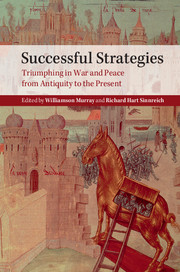Book contents
- Frontmatter
- Dedication
- Contents
- List of tables and map
- List of contributors
- Acknowledgments
- Introduction
- 1 The strategic thought of Themistocles
- 2 The grand strategy of the Roman Empire
- 3 Giraldus Cambrensis, Edward I, and the conquest of Wales
- 4 Creating the British way of war: English strategy in the War of the Spanish Succession
- 5 Failed, broken, or galvanized?
- 6 Victory by trial and error: Britain’s struggle against Napoleon
- 7 The strategy of Lincoln and Grant
- 8 Bismarckian strategic policy, 1871–1890
- 9 Dowding and the British strategy of air defense 1936–1940
- 10 US naval strategy and Japan
- 11 US grand strategy in the Second World War
- 12 American grand strategy and the unfolding of the Cold War 1945–1961
- 13 The Reagan administration’s strategy toward the Soviet Union
- Afterword
- Index
- References
4 - Creating the British way of war: English strategy in the War of the Spanish Succession
Published online by Cambridge University Press: 05 June 2014
- Frontmatter
- Dedication
- Contents
- List of tables and map
- List of contributors
- Acknowledgments
- Introduction
- 1 The strategic thought of Themistocles
- 2 The grand strategy of the Roman Empire
- 3 Giraldus Cambrensis, Edward I, and the conquest of Wales
- 4 Creating the British way of war: English strategy in the War of the Spanish Succession
- 5 Failed, broken, or galvanized?
- 6 Victory by trial and error: Britain’s struggle against Napoleon
- 7 The strategy of Lincoln and Grant
- 8 Bismarckian strategic policy, 1871–1890
- 9 Dowding and the British strategy of air defense 1936–1940
- 10 US naval strategy and Japan
- 11 US grand strategy in the Second World War
- 12 American grand strategy and the unfolding of the Cold War 1945–1961
- 13 The Reagan administration’s strategy toward the Soviet Union
- Afterword
- Index
- References
Summary
Over the course of the seventeenth century, England had emerged from its position as a peripheral second-rate power to become a core partner in a European-wide coalition united against Louis XIV’s France. Its participation in the War of the Spanish Succession (1702–1712) cemented the country’s status as a great power. Its military victories were critical to this transition, and the strategic approaches that directed its forces led to a peace shaped largely by English concerns. Unlike the rest of Europe, England was in the fortunate position of possessing real strategic options. Its geographical location allowed it to draw on two distinct schools of strategic thought: a focus on its foe in Europe (a continental strategy), or on the unfolding vista of overseas territories and the trade they brought back to Europe (a “blue water” strategy).
The conduct of the Nine Years’ War (1688–1697) inaugurated an uneasy amalgamation of these two traditions, but it required the War of Spanish Succession to turn England’s strategy into a fully ‘English’ one. The decision to enter the war as a major participant of a grand coalition, wage a full-scale war against France’s armies and navies in multiple theaters while simultaneously targeting the French economy, sustain such a massive effort by mobilizing the resources of a broad coalition, and end the war on its own terms help to explain England’s ultimate success. In addition to providing the stepping stones for future British success, the strategic decisions of the War of the Spanish Succession also helped establish a model for future British strategy: a distinctive way of war.
- Type
- Chapter
- Information
- Successful StrategiesTriumphing in War and Peace from Antiquity to the Present, pp. 100 - 129Publisher: Cambridge University PressPrint publication year: 2014
References
- 1
- Cited by



